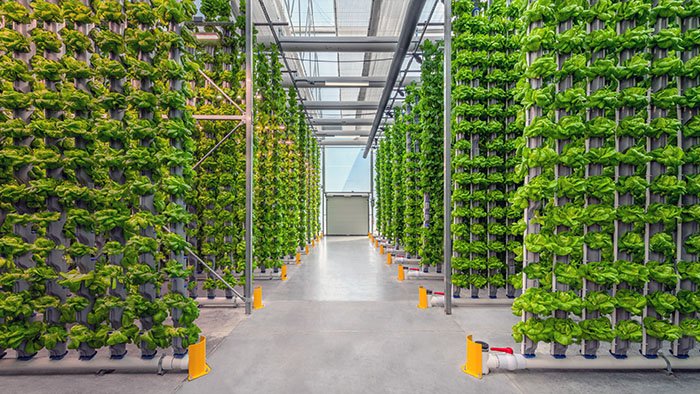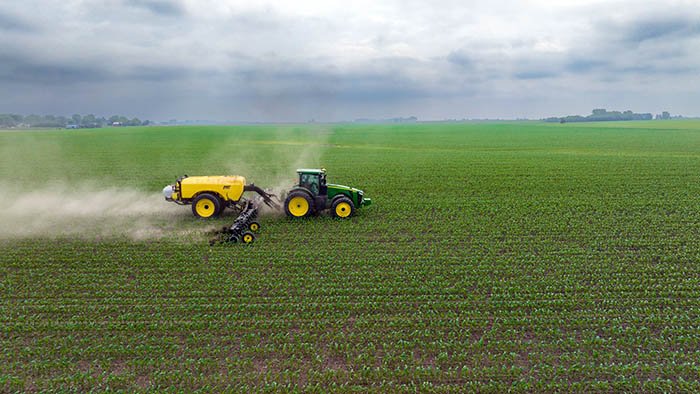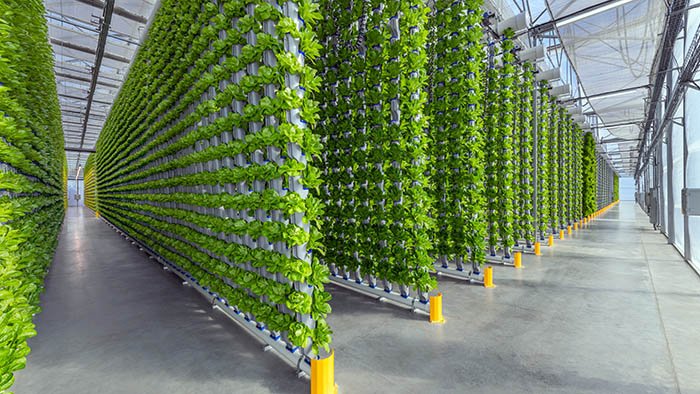Hydroponics vs. Traditional Farming: A Comprehensive Comparison
Inside Eden Green’s Hydroponic Vertical Farm
If you’ve heard about a fascinating new way of growing crops called hydroponics, and you’re wondering about all the fuss, we have your answers. Learn about hydroponic farming vs. traditional farming below.
-
An introduction to hydroponics, a method of growing plants that substitutes water for soil, allowing crops to be grown all year indoors, regardless of climate, season, or weather conditions
The different types of hydroponic systems, including Nutrient Film Technique (NFT), Aeroponics, Deep Water Culture (DWC), Ebb and Flow (Flood and Drain), and Drip Systems
The components of traditional farming, including soil preparation, planting and growing, pest and disease control, fertilization, irrigation, harvesting, and post-harvest handling
A comparison of efficiency and yield between hydroponics and traditional farming
The space requirements for both methods
The water and resource usage of both methods
The environmental impact of both methods
The climate-proof nature of hydroponics
The crop variety and flexibility in both methods
The seasonally agnostic nature of hydroponics
The lower risk of contamination in hydroponics
The potential for less food waste in hydroponics
The initial investment and maintenance costs of both methods
Frequently asked questions about hydroponics, including its benefits, taste of the crops, growth time, need for sunlight, and advantages over traditional farming
Comparison: Hydroponics vs. Traditional Farming
| Criteria | Hydroponics | Traditional Farming |
|---|---|---|
| Efficiency and Yield | Higher efficiency and yield due to controlled environment. | Dependent on natural conditions, generally lower yield. |
| Space Requirements | Less space required due to vertical farming. | Requires more land area. |
| Water and Resource Usage | Uses less water but may require more energy. | Higher water usage and less energy-efficient. |
| Environmental Impact | More sustainable, less impact on soil and water. | Can contribute to soil degradation and water pollution. |
| Climate-Proof | Can grow crops in any climate. | Dependent on climate and weather conditions. |
| Crop Variety and Flexibility | Limited to certain types of crops. | Can grow a wider variety of crops. |
| Seasonal Dependency | Not dependent on seasons. | Season-dependent. |
| Contamination Risk | Lower risk due to controlled environment. | Higher risk due to open-air farming. |
| Food Waste | Less food waste due to proximity to consumers. | More food waste due to longer transit times. |
| Initial Investment and Maintenance Costs | Higher initial investment but potentially lower maintenance costs. | Lower initial investment but potentially higher maintenance costs. |
What is Hydroponics?
Hydroponics is a plant-growing method that substitutes water for soil. There are several different methods of managing this, but the basics involve planting crops with their roots exposed to water fortified with added nutrients. This method is increasing in popularity because crops can be grown all year indoors, regardless of climate, season, or weather conditions.
Types of Hydroponic Systems
There are various ways to manage a hydroponic growing environment. Here are five of the most popular hydroponic system types.
Nutrient Film Technique (NFT)
Nutrient film technique (NFT) hydroponic systems constantly flow water past the roots of the plants in the system. Think of NFT systems as the artificial version of a natural phenomenon you may have observed in the wild. If you’ve ever seen plants on the edge of a river bank where the soil beneath has eroded, and the plant roots dangle directly into the river, this is a very similar set-up.
Aeroponics
Aeroponic systems are a subset of hydroponics wherein the plants are grown with their roots dangling in the air. Misting systems below the plants then periodically spray a combination of water and nutrients directly onto the exposed roots.
For more information, we wrote a guide on the differences between Aeroponics and Hydroponics.
Deep Water Culture (DWC)
In deep water culture (DWC) systems, plants are grown suspended above a water reservoir with added nutrients. The plant’s roots are submerged in the water constantly. Growers use air pumps and air stones in the water to provide enough oxygen to the plants to prevent root rot.
Ebb and Flow (Flood and Drain)
In an ebb-and-flow system, the plants’ roots dangle above a tray or other container that is periodically flooded, then drained. This type of system is a favorite for DIY enthusiasts as it is one of the easiest to construct and maintain.
Drip Systems
Hydroponic drip systems are based on drip irrigation systems used in arid climates like the Israeli desert. In this growing method, a pump feeds water and nutrients into small emitters that drip the solution directly onto plant roots.
What is Traditional Farming?
When we mention traditional farming, we're discussing the commercial farms you see in the heartland of America. Acres of soil are planted with rows of crops, typically one type of crop per field. Farmers must irrigate these crops and apply pesticides and fertilizers to protect and feed their crops. At harvest time, many traditional farms still rely on farm labor to pick fruits and vegetables. Others may have various automated means of harvesting.
Components of Traditional Farming
Soil preparation
There are three primary ways of preparing soil for planting. Farmers may use some or all of the following steps to prepare their fields.
Plowing — Farmers loosen the soil by digging into it. This action can bring nutrients to the surface and increase aeration.
Leveling — After plowing the land, many farmers level it by dragging a flat piece of wood or metal across the surface. This step helps keep loose soil from blowing or washing away. It can also help irrigation water the field more evenly.
Fertilizing — It’s time to add more nutrients to the field. Farmers may choose to use natural fertilizers such as manure or chemical fertilizers designed for the purpose.
Planting and Growing
Once the soil has been prepared, it’s time to plant. Typically, farmers drive a tractor across the field with an attachment that sows seeds. These attachments actually perform several functions at once:
Clear the soil of any debris.
Create a long narrow trench called a furrow.
Drop the seed into the furrow at evenly spaced intervals.
Close the soil over the seed.
Planters are carefully tuned to each type of crop they plant. They sow seeds at a specific distance apart and dig them to the correct depth for the current soil conditions.
Pest and disease control
Crops grown outdoors are often susceptible to problems like pests, weeds, and diseases. Most commercial farms apply insecticides, herbicides, and fungicides across their fields to protect crops against these problems. Some farmers have also adopted genetically modified versions of popular crops designed to resist these problems.
Fertilization
Fertilization, or nutrient management, is a critical component of commercial farming. Farmers will test the soil throughout the growing season to determine which nutrients are lacking, then add these nutrients as fertilizers. The primary nutrient types typically managed include nitrogen (N), phosphorus (P), and potassium (K), and you will often see NPK ratios listed on commercial fertilizers.
Irrigation
Much of the farmland in the U.S. (and worldwide) must be irrigated to ensure crops receive enough moisture to grow and thrive. Most commercial growers use three primary types of irrigation:
Surface irrigation — basins, canals, or furrows are flooded to distribute water through the field.
Sprinkler irrigation — hoses, pipes, and pressurized sprinkler heads spray water across the field.
Drip irrigation — much like the hydroponic growing method, soaker hoses, and other methods constantly drip or trickle small amounts of water directly onto crops.
Harvesting and post-harvest handling
Once the crops have reached full maturity, it’s time for the harvest. Some crops, such as most grains, are harvested by machine. This technique may lead to food waste but is far cheaper and safer than farm labor. Other crops are more delicate and must be harvested by hand. In these instances, farm labor is brought in temporarily to manage the harvest.
Different types of handling must occur once the crop has been harvested to prepare it for commercial sale. This post-harvest handling may include drying, dehulling, cleaning, sorting, and packaging, depending on the type of crop involved.
Hydroponics vs. Soil Farming: Key Comparisons
When comparing hydroponics vs. traditional farming, we must consider several factors.
Efficiency and Yield
Because hydroponic systems are often housed indoors, they can produce crops year-round. Crops often grow faster in such systems due to the ready availability of nutrients in the water and ideal climate conditions.
Winner: Hydroponics
Space Requirements
Traditional farming methods take up a lot of space because the plants must all be grown at ground level. Most systems use vertical farming methods in hydroponic growing and stacking plants in trays or towers. This ability to use vertical space means growers can plant more crops in a smaller area.
Winner: Hydroponics
Water and Resource Usage
Perhaps surprisingly, most hydroponic systems use less water than traditional farms. This is because they can repeatedly recycle the same water through the system, with little or no water lost to the water table or evaporation. On the other hand, energy consumption is often significant in systems that rely entirely on grow lights to feed their plants.
Winner: Mixed
Sustainable Farming and Environmental Impact
In addition to using less water, hydroponic systems tend to be far more sustainable because they do not contribute to topsoil degradation and don’t need chemical fertilizers and pesticides to protect their crops.
Winner: Hydroponics
Climate-Proof
It’s widely understood that our climate is changing dramatically, significantly impacting traditional farming. Hydroponic farms, on the other hand, can grow crops in climates that are wholly unsuitable for outdoor growing. Cold-weather crops can be produced in the tropics, while warm-climate crops thrive in the tundra.
Winner: Hydroponics
Crop Variety and Flexibility
Most hydroponic farms grow produce like leafy greens, herbs, or microgreens. Some other crops, like strawberries and peppers, have also been adapted to various systems. Yet other crops will likely never work in a hydroponic environment, particularly those grown underground, like peanuts, potatoes, carrots, and onions.
Winner: Traditional farming
Seasonally Agnostic
While traditional farms are at the mercy of nature, indoor hydroponic farms are season agnostic. Regardless of the temperature or weather conditions outside, growers can set the ideal conditions for their plants indoors.
Winner: Hydroponics
Contamination
If you’ve ever been affected by a fruit or vegetable recall, you understand the dangers associated with crop contamination. Open-air crops are susceptible to all sorts of contamination, while hydroponic crops are often grown in laboratory-like conditions where accidental contamination is almost impossible.
To learn more, read our article on Hydroponic Food Safety.
Winner: Hydroponics
Less Food Waste
Because it uses far less space and doesn’t need soil, indoor farming can thrive in nearly any environment, including densely populated urban areas. This versatility means that crops don’t have to be transported for miles and miles to reach consumers. Since so much food waste occurs in transit, hydroponic crops come out on top here.
Winner: Hydroponics
Initial Investment and Maintenance Costs
Traditional farms are far less expensive to set up than commercial hydroponic farms. As hydroponic technologies are more widely adopted, they will likely also become less expensive, but at least for now, traditional farming wins when considering cost alone.
Winner: Traditional farming
Frequently Asked Questions (FAQs)
Is hydroponics better than soil?
We must consider many factors here, but our hydroponic systems offer the following benefits:
98% less water usage than traditional farming
99% less land usage than traditional farming
Meet or exceed the strictest SQF Institute food safety standards
Climate and season-agnostic growing, year-round
Do hydroponic plants taste better?
There is a common misconception that hydroponic crops will taste watered down, but this simply isn't true in a properly-managed hydroponic system. Since these crops can be grown closer to consumers than traditional crops, they tend to be fresher and taste better.
How long does it take plants to grow using hydroponics?
While this depends greatly on the type and variety of crop being grown, most of our crops can be harvested within 30-45 days.
Do hydroponic plants need sunlight?
Sunlight is the best light source for growing plants of all sorts. But when properly designed and calibrated, artificial lighting systems can offer everything plants need to grow and thrive.
What are the 3 advantages of hydroponic farming?
While there are many benefits to hydroponics, here are just a few examples:
Hydroponic farms take up far less space and need no soil. They can be grown almost anywhere, including harsh climates and dense urban settings.
Hydroponic plants are protected from pests, weeds, most diseases, and contamination. This means more predictable yields and far less chance of food recalls.
Hydroponic farms that use sunlight as much as possible are far more environmentally responsible than most traditional commercial farming methods. They use less water, do not deplete topsoil, and don’t contaminate the environment with harmful chemicals like pesticides and herbicides.
Are you an investor or a produce buyer looking to invest in sustainable farming methods? Contact us today to learn how Eden Green Technologies can help you achieve your goals.




